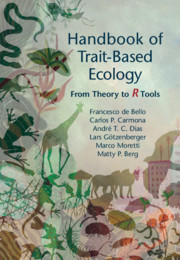Book contents
- Handbook of Trait-Based Ecology
- Handbook of Trait-Based Ecology
- Copyright page
- Epigraph
- Contents
- Preface
- 1 General Introduction
- 2 Trait Selection and Standardization
- 3 The Ecology of Differences
- 4 Response Traits and the Filtering Metaphor
- 5 Community Metrics
- 6 Intraspecific Trait Variability
- 7 Community Assembly Rules
- 8 Traits and Phylogenies
- 9 Effects of Traits on Ecosystem Processes and Services
- 10 Response and Effect Traits across Trophic Levels
- 11 Trait Sampling Strategies
- 12 Applied Trait-Based Ecology
- References
- Index
7 - Community Assembly Rules
Published online by Cambridge University Press: 08 March 2021
- Handbook of Trait-Based Ecology
- Handbook of Trait-Based Ecology
- Copyright page
- Epigraph
- Contents
- Preface
- 1 General Introduction
- 2 Trait Selection and Standardization
- 3 The Ecology of Differences
- 4 Response Traits and the Filtering Metaphor
- 5 Community Metrics
- 6 Intraspecific Trait Variability
- 7 Community Assembly Rules
- 8 Traits and Phylogenies
- 9 Effects of Traits on Ecosystem Processes and Services
- 10 Response and Effect Traits across Trophic Levels
- 11 Trait Sampling Strategies
- 12 Applied Trait-Based Ecology
- References
- Index
Summary
Chapter 7 expands on the ideas already introduced in Chapters 4 and 6 on community assembly rules, understood as any constraint restricting the number and identity of the species observed in an assemblage. The different ecological processes behind such rules are discussed, together with the expected effects of these rules on trait patterns (trait convergence vs trait divergence) at different ecological scales. The importance of defining a proper reference species pool for assessing these mechanisms is explained. A further discussion is provided on the difficulty of ascertaining the specific ecological processes leading to observed patterns of trait variation without experimental approaches. This leads to introducing how null models and data randomizations can provide valuable insight into different assembly rules mechanisms, when proper care is given to considering the effect of scale and an adequate reference species pool. The R examples accompanying this chapter provide different tools to implement a variety of null models in combinations with functional diversity indices.
Keywords
Information
- Type
- Chapter
- Information
- Handbook of Trait-Based EcologyFrom Theory to R Tools, pp. 129 - 150Publisher: Cambridge University PressPrint publication year: 2021
Accessibility standard: Unknown
Why this information is here
This section outlines the accessibility features of this content - including support for screen readers, full keyboard navigation and high-contrast display options. This may not be relevant for you.Accessibility Information
- 3
- Cited by
